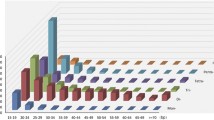Abstract
Microsatellites or simple sequence repeats (SSRs) may display polymerase-chain-reaction-amplified fragment lengths mismatching the patterns expected from repeat copy number variation. We sequenced alleles of a nuclear dinucleotide SSR locus in two oak species which showed 2- and 1-bp length differences between alleles and three types of stuttering patterns in fragment length analysis. In accordance with the variation in stuttering, we identified three allele classes characterized by insertions–deletions in the flanking regions and overlapping repeat copy number ranges. Different alleles could thus only be safely separated when considering these stuttering patterns. Our results raise the question of how to adequately delimit alleles when such size homoplasy is present. We advise to thoroughly characterize SSR sequence variation during marker development and to carefully place primer sites along flanking regions to facilitate automated allele scoring and to minimize labor-intensive visual inspection.


Similar content being viewed by others
Abbreviations
- bp:
-
base pair
- FLA:
-
fragment length analysis
- indel:
-
insertion–deletion
- nSSR:
-
nuclear simple sequence repeat
- PCR:
-
polymerase chain reaction
References
Adams RI, Brown KM, Hamilton MB. The impact of microsatellite electromorph size homoplasy on multilocus population structure estimates in a tropical tree (Corythophora alta) and an anadromous fish (Morone saxatilis). Mol Ecol. 2004;13(9):2579–88.
Brohede J, Ellegren H. Microsatellite evolution: polarity of substitutions within repeats and neutrality of flanking sequences. Proc R Soc Lond B. 1999;266(1421):825–33.
Curtu A-L, Finkeldey R, Gailing O. Comparative sequencing of a microsatellite locus reveals size homoplasy within and between European oak species (Quercus spp.). Plant Mol Biol Reptr. 2004;22(4):339–46.
Ellegren H. Microsatellites: simple sequences with complex evolution. Nat Rev Genet. 2004;5(6):435–45.
Estoup A, Jarne P, Cornuet J-M. Homoplasy and mutation model at microsatellite loci and their consequences for population genetics analysis. Mol Ecol. 2002;11(9):1591–604.
Goldstein DB, Schlötterer C. Microsatellites: evolution and application. Oxford: Oxford University Press; 1999.
González-Martínez SC, Robledo-Arnuncio JJ, Collada C, et al. Cross-amplification and sequence variation of microsatellite loci in Eurasian hard pines. Theor Appl Genet. 2004;109(1):103–11.
Gugerli F, Walser J-C, Dounavi K, et al. Coincidence of small-scale spatial discontinuities in leaf morphology and nuclear microsatellite variation of Quercus petraea and Q. robur in a mixed forest. Ann Bot. 2007;99(4):713–22.
Hoffman JI, Amos W. Microsatellite genotyping errors: detection approaches, common sources and consequences for paternal exclusion. Mol Ecol. 2005;14(2):599–612.
Kampfer S, Lexer C, Glössl J, et al. Characterization of (GA)(n) microsatellite loci from Quercus robur. Hereditas 1998;129(2):183–6.
Kimura M, Ohta T. Stepwise mutation model and distribution of allelic frequencies in a finite population. Proc Natl Acad Sci U S A. 1978;75(6):2868–72.
Lexer C, Kremer A, Petit RJ. Shared alleles in sympatric oaks: recurrent gene flow is a more parsimonious explanation than ancestral polymorphism. Mol Ecol. 2006;15(7):2007–12.
Muir G, Schlötterer C. Moving beyond single-locus studies to characterize hybridization between oaks (Quercus spp.). Mol Ecol. 2006;15(8):2301–4.
Ortí G, Pearse DE, Avise JC. Phylogenetic assessment of length variation at a microsatellite locus. Proc Natl Acad Sci U S A. 1997;94(20):10745–9.
Reece KS, Ribeiro WL, Gaffney PM, et al. Microsatellite marker development and analysis in the Eastern Oyster (Crassostrea virginica): confirmation of null alleles and non-Mendelian segregation ratios. J Hered. 2004;95(4):346–51.
Schlötterer C. Genome evolution: are microsatellites really simple sequences. Curr Biol. 1998;8(4):R132–4.
Selkoe KA, Toonen RJ. Microsatellites for ecologists: a practical guide to using and evaluating microsatellite markers. Ecol Lett. 2006;9(5):615–29.
Shepherd LD, Lambert DM. Mutational bias in penguin microsatellite DNA. J Hered. 2005;96(5):566–71.
Steinkellner H, Fluch S, Turetschek E, et al. Identification and characterization of (GA/CT)n-microsatellite loci from Quercus petraea. Plant Mol Biol. 1997;33(6):1093–6.
Zhang D-X, Hewitt GM. Nuclear DNA analyses in genetic studies of populations: practice, problems and prospects. Mol Ecol. 2003;12(3):563–84.
Acknowledgements
This work was carried out in the framework of the European project Oakflow (CT-FAIR 2000-00960), which was financially supported by the Swiss Federal Office for Education and Science (BBW 99.0838). We thank Christoph Sperisen for providing technical support and an anonymous referee for helpful comments on the manuscript.
Author information
Authors and Affiliations
Corresponding author
Rights and permissions
About this article
Cite this article
Gugerli, F., Brodbeck, S. & Holderegger, R. Insertions–Deletions in a Microsatellite Flanking Region May Be Resolved by Variation in Stuttering Patterns. Plant Mol Biol Rep 26, 255–262 (2008). https://doi.org/10.1007/s11105-008-0034-7
Published:
Issue Date:
DOI: https://doi.org/10.1007/s11105-008-0034-7



